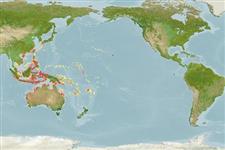Classification / Names
Common names from other countries
Main reference
Size / Weight / Age
Max length : 7.3 cm TL male/unsexed; (Ref. 7050)
Environment
Marine; freshwater; brackish; reef-associated; amphidromous (Ref. 46888); depth range 1 - 15 m (Ref. 90102)
Climate / Range
Tropical, preferred ?; 28°N - 35°S
Distribution
Short description
Dorsal
spines
(total): 7;
Dorsal
soft rays
(total): 10;
Anal
spines: 1;
Anal
soft rays: 8. Characterized by mottled brown with dark stripe from snout, through eye to upper opercle; dark brown bars of variable width at level of nape, posterior part of first dorsal fin, anterior part of second dorsal fin, posterior half of second dorsal fin and across caudal peduncle; upper edge of caudal fin with intense black spot; completely united pelvic fins with well-developed frenum; pointed caudal fin; longitudinal scale series 40-45; cycloid scales on nape, cheek, opercle, base of pectoral fin, breast and belly, posterior scales ctenoid; predorsal scales 20-22; head with prominent papillae ridge; depth of body 5.4-6.0 in SL (Ref. 90102).
IUCN Red List Status (Ref. 115185)
Threat to humans
Harmless
Human uses
Aquarium: commercial
More information
Common namesSynonymsMetabolismPredatorsEcotoxicologyReproductionMaturitySpawningFecundityEggsEgg development
ReferencesAquacultureAquaculture profileStrainsGeneticsAllele frequenciesHeritabilityDiseasesProcessingMass conversion
Tools
Special reports
Download XML
Internet sources
Estimates of some properties based on models
Phylogenetic diversity index
PD50 = 0.5000 many relatives (e.g. carps) 0.5 - 2.0 few relatives (e.g. lungfishes)
Trophic Level
3.1 ±0.4 se; Based on diet studies.
Resilience
High, minimum population doubling time less than 15 months (Preliminary K or Fecundity.)
Vulnerability
Low vulnerability (15 of 100)
Price category
